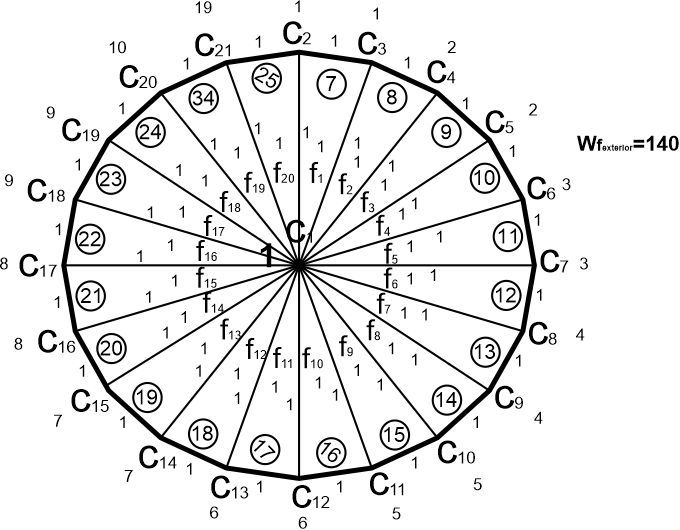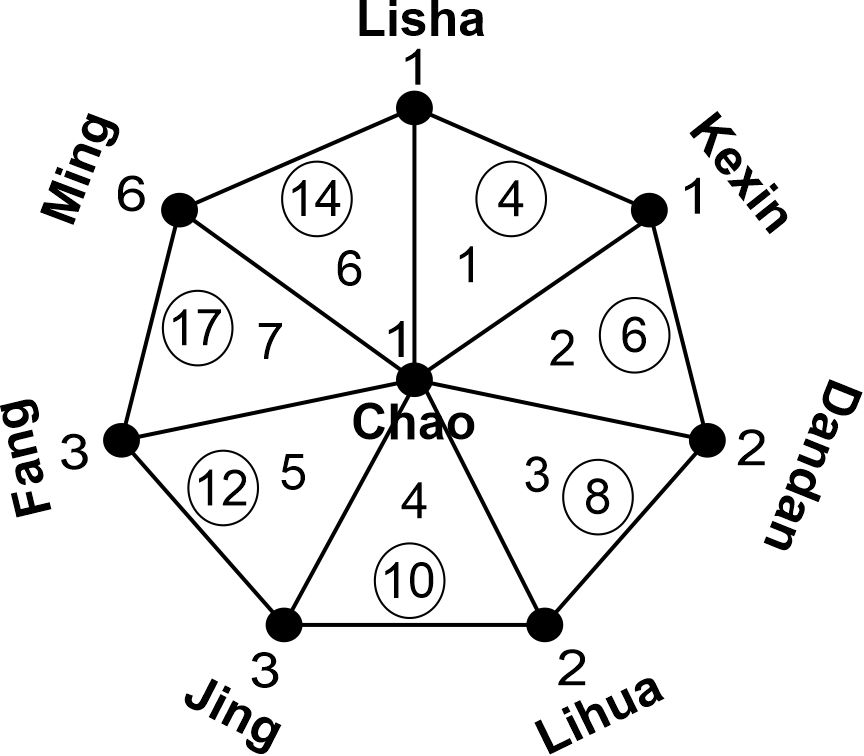Graph theory is playing vital role in almost every field of our routine life. You make a conference call with your friends by using vertices (yourself and your friends) and edges (network connection). You construct a printed grid floor with different faces in your home by the help of graph theory. Authors in this study are using labelling of graphs and applying it in choosing best friends around you. The helping graphs in this article will be plane graphs which will be labelling under
Graph theory has wide applications in different fields of our routine
life. For example, finding shortest route on Google maps, analyzing
electrocardiogram (ECG)of a cardiac patient, managing security in
housing societies, connecting people with Facebook and Whatsapp,
handling transportation system etc. In this article, writers are
focussing on applying the subtopic of graph theory, that is, face
irregularity strength, to different daily routines of everyday life
where six or more components (including people) will be attached.
Mathematical graphs which are under consideration in this study are
wheel graphs with six or more vertices. Writers have applied a similar
application on a school with nine busses. After the successful
application of this system, authors realized to publish it for the
people around. All graphs
Reader should know some basic definitions which will be helpful in
reading this paper. A simple graph is a graph which has no loop and
multiple edges [1]. A connected graph is a
graph where you can move from one vertex to another by an edge [2]. If all the
vertices of a graph have same degree then such a graph is called regular
graph. A graph will be
If the vertices of a graph do not have same degree then we call such
graphs as irregular graphs [1]. If no two edges of a
graph intersect each other then we say that graph is a planar graph
[2]. Graph
labelling is putting positive integers to vertices, edges and faces of
the graph [3]. Weight of vertex of a graph
can be calculated by adding the labels of the particular vertex and its
surrounding edges, weight of an edge can be calculated by adding labels
of two vertices surrounding that particular edge and the label of edge
itself, weight of face can be calculated by adding the labels of
surrounding vertices, edges and the label of that particular face
itself. Let
The whole discussion will round over the domains
The vertex set and edge set for wheel graphs can be written as
Graph theory is applicable on every field around us. Authors in this
study are applying the subtopic of graph theory, that is, face
irregularity strength, on some particular fields where one component may
be attached with other components surrounding it. The Figure 1 represents a general diagram which can
be fixed to any application of face irregularity strength.
Mathematically, it represents a wheel graph with twenty-one vertices,
forty edges and twenty-one faces including the external face. The
labeling used in this diagram is

Theorem 1. Let
Proof. Faces of the graph can be labeled under
Theorem 2. Let
Proof. We prove this theorem by mathematical induction. For
Now suppose that the results are true for
import java.util.ArrayList;
import java.util.List;
public class WheelGraph {
public static void main(String[] args) {
int n = 21; // Number of vertices
List<List<Integer>> adjList = constructWheelGraph(n);
printGraph(adjList);
}
// Step 1: Function to construct a wheel graph with n vertices
public static List<List<Integer>> constructWheelGraph(int n) {
// Step 2: Initialize the adjacency list
List<List<Integer>> adjList = new ArrayList<>();
for (int i = 0; i < n; i++) {
adjList.add(new ArrayList<>());
}
// Step 3: Connect the outer cycle
for (int i = 0; i < n - 1; i++) {
adjList.get(i).add((i + 1) % (n - 1));
adjList.get((i + 1) % (n - 1)).add(i);
}
// Step 4: Connect the hub vertex to all outer vertices
for (int i = 0; i < n - 1; i++) {
adjList.get(n - 1).add(i);
adjList.get(i).add(n - 1);
}
return adjList;
}
// Step 5: Function to print the adjacency list representation
of the graph
public static void printGraph(List<List<Integer>> adjList) {
for (int i = 0; i < adjList.size(); i++) {
System.out.print("Vertex " + i + " is connected to: ");
for (int neighbor : adjList.get(i)) {
System.out.print(neighbor + " ");
}
System.out.println();
}
}
}Chao has a friends circle. He always face deceit from his friends. He
is going to use face irregularity strength of graphs to find sincere
friends in his circle. Chao has seven friends who are always close to
him but he is confused to choose the best of them. He does not want to
face deceit again. The Figure 2 shows that
chao is using a popular graph in graph theory to choose his friends.
This graph is a wheel graph, which is labelled under
Chao categorizes his friends into a wheel graph with six faces and every face contains three friends. His sixth sense works well now because he has faced many frauds in his life so he uses his sixth sense and gives numbering to every face of the graph. The condition behind these numbering is that the face weights should be distinct. Moving from top to clock wise, we see that numberings given by chao to the faces are, 1, 2, 3, 4, 5, 7 and 6. The condition of this k-numbering is that the face weights should be distinct which you can clearly see from the Figure 2. The face weights are shown in the circles inside each face, which are 4, 6, 8, 10, 12, 17 and 14 if we move in clock wise direction from Lisha.
Now the decision time comes here. Chao will first check the face irregularity strength of this graph. The face irregularity strength of a graph is the minimum integer (from the set of integers) in a graph for which the face weights are distinct. We can see clearly that the face irregularity strength of the Figure 2 is 7 which falls in the face containing Fang, Ming and Chao. So now chao has to choose Fang or Ming. Chao gave them number 7 because he was already interested in both of them because of their good traits. But chao has to choose one of them so he will go for Ming because Ming has much better traits as compare to Fang. So face irregularity strength in graph theory made it easy for chao to choose a best lifetime friend. Graph theory itself plays very important character in our everyday life problems but now the subtopics of graph theory need to apply on our routine life, which authors have done in this research.

Remember that the numberings which chao used in his graph need not to
be in order. You can assign integers according to your own wish but the
face weight should be distinct and the least possible integers need to
be used in your labelling. The numbers which are given to the edges and
faces can also be others except one but you have to focus the whole
graph, like, if you are giving a number 14 to the vertices then try to
use a number less than 14 for the faces or edges. For larger number
applications, you can use a scale to put them in a label form. For
example, if you want to use the total number of engineering students of
India in the graph then you can use scale, like,
Authors in this study made a user friendly system for the solution of our everyday routine life problems. They highlighted the environment for vertex, edge, face, total, edge-face, vertex-face and entire. This shows that almost every problem of everyday life can be dissolved according to this model. Writers applied this study on a local school which was successful in making cost effective transport system. In future, there is still much more space where applications of graph theory can be fixed.
1970-2025 CP (Manitoba, Canada) unless otherwise stated.